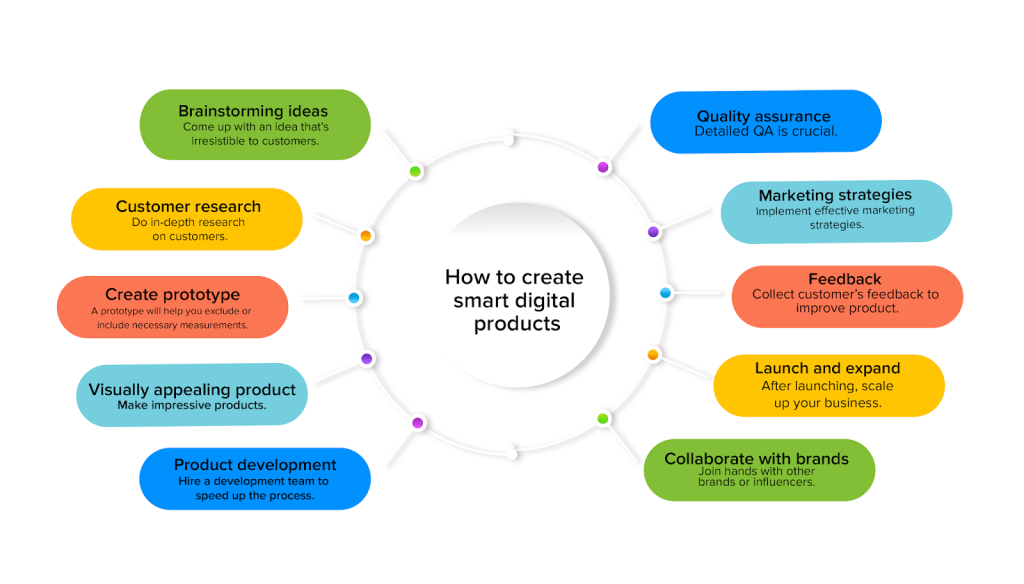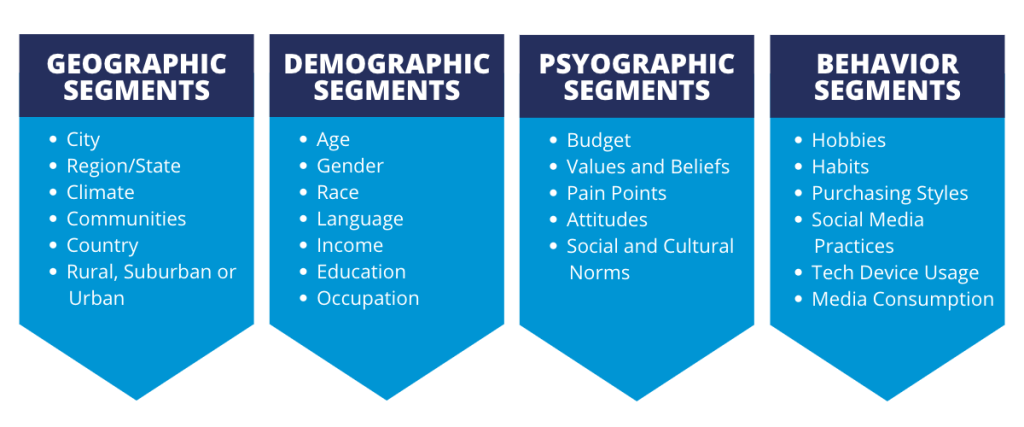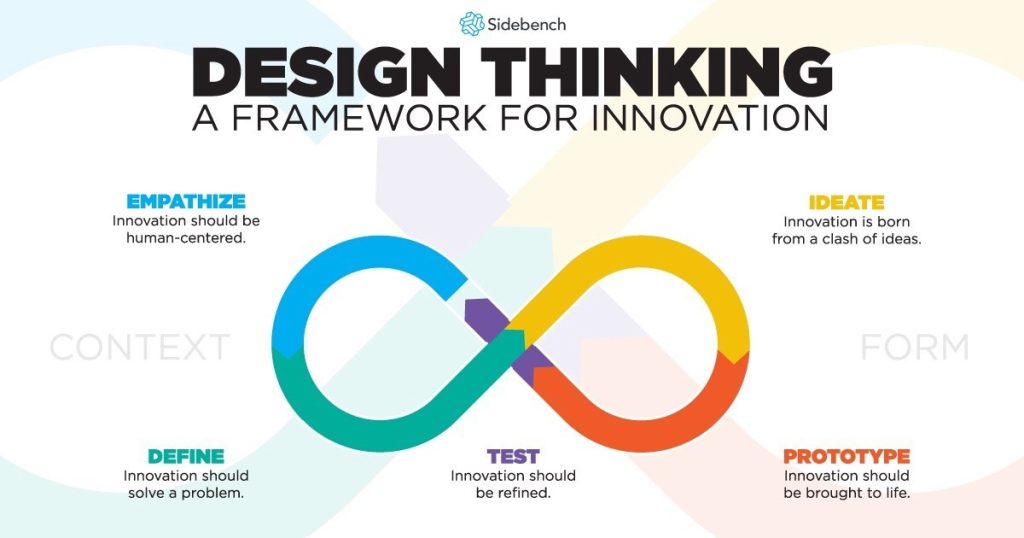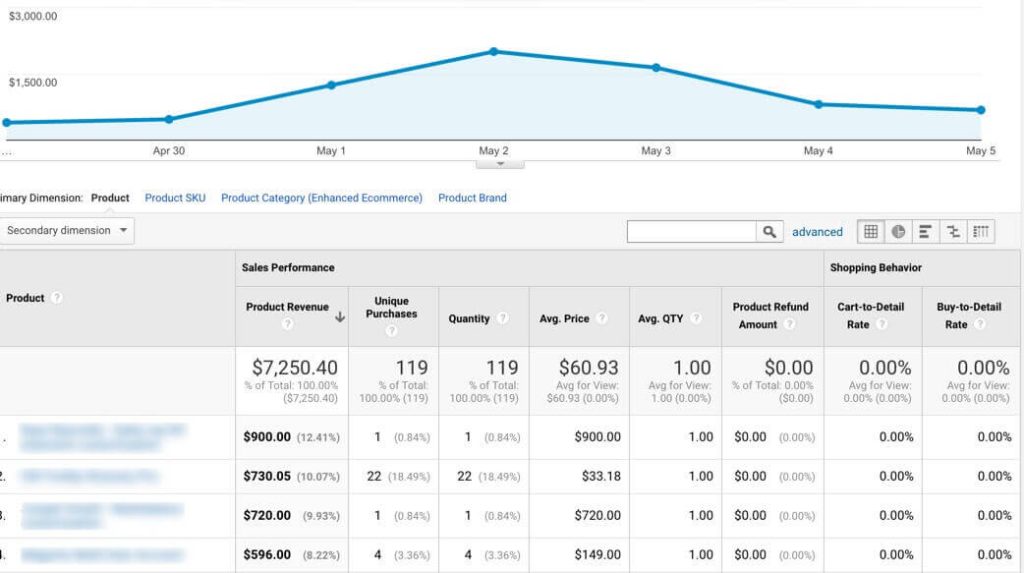Discover the ultimate guide to succeed in the digital business world. Make money by monetizing your expertise. Learn the basics of creating and selling digital products. From innovative ideas to maximizing profits, it explores market research, content quality, and strategic marketing techniques. Learn the art of leveraging social media, SEO, and email campaigns to boost traffic and increase sales. Packed with practical tips, real examples, and expert insights, this guide empowers you to turn your passion into a lucrative digital venture. Let’s embark on this exciting journey together!
Why create and sell digital products?
In the present era of digital advancements, creating and selling digital products have gained significant traction as a lucrative avenue to capitalize on your expertise and knowledge. Diverging from tangible goods, digital products possess the unique characteristic of being crafted once and repeatedly sold, thereby enabling the accumulation of passive income.
Moreover, the entry barriers are notably lower than conventional enterprises, making it accessible to individuals armed with only a computer and an internet connection. Digital products encompass many forms, including ebooks, online educational programs, templates, software solutions, and more. The potential for scalability and profitability is vast, rendering it an appealing business prospect for aspiring entrepreneurs.
Before embarking on digital product creation, comprehending its inherent benefits and advantages is crucial. A key advantage lies in the capacity to reach a global audience. The internet has forged connections among individuals across the globe, facilitating access to digital products by people from diverse countries and cultures. This expansion unlocks new markets and exponentially enlarges your customer base.
Furthermore, digital product creation involves considerably lower overhead costs. Unlike brick-and-mortar businesses that require physical premises and inventory, digital products can be crafted and delivered online, obviating physical infrastructure. This translates to augmented profit margins and reduced risks.
Lastly, digital products can be effortlessly updated and enhanced in response to customer feedback, ensuring a continual value delivery to your audience.
Different types of digital products
When it comes to developing and distributing digital products, the possibilities are limitless. Below are some popular categories of digital products that you can explore:
Ebooks and guides
Composing ebooks and informative materials is a prevalent form of digital product creation. These resources allow you to share your expertise and insights in an organized manner. You can develop a valuable ebook or guide regardless of specialization, such as cooking, fitness, personal finance, or any other niche. These digital products can be conveniently delivered in PDF format, ensuring accessibility across multiple devices.
Online courses and workshops
Online courses and interactive workshops have experienced a surge in popularity recently. For individuals seeking to enhance their knowledge or acquire new skills, these platforms offer structured educational opportunities. Courses can be offered on platforms like Udemy, Teachable, or your website. Incorporating video lessons, quizzes, assignments, and interactive elements ensures engaging learning experiences and maximizes comprehension.
Templates and designs
Both individuals and businesses actively seek out templates and designs for various purposes. Offering pre-designed assets, such as website templates, graphic designs, resume templates, or social media templates, can be lucrative. Templates and designs save customers time and effort, allowing them to personalize and customize their projects without starting from scratch.
Software and apps
Proficiency in programming can lead to the development of profitable software and applications. From productivity tools to mobile apps, a broad range of software solutions cater to specific needs or target particular audiences. With the growing dependence on technology, the demand for inventive software and apps continues to rise.
Membership sites and digital subscriptions
Digital subscriptions and membership sites provide exclusive content and benefits to subscribers. Premium blogs, community forums, and access to exclusive resources are examples of offerings that can generate recurring revenue through monthly or annual subscriptions. This model enables the development of a loyal community and the continuous delivery of value to subscribers.
These examples merely scratch the surface of the diverse array of digital products available. The key lies in identifying your strengths, expertise, and target audience to determine which type of digital product aligns with your skills and market demand.

Credit: appinventiv.com
Discovering Lucrative Ideas for Digital Products
Once you have determined the type of digital product you intend to develop, the next step is to explore profitable concepts. Here are some practical approaches to help you generate innovative and high-demand ideas for digital products:
Identify your passion and expertise
Commence by recognizing your genuine interests and areas of expertise. What truly captivates you? What unique skills and knowledge do you possess? By focusing on your passions and areas of expertise, you can create digital products that genuinely inspire you and provide significant value to your target audience.
Research market trends and gaps
Conduct comprehensive market research to identify emerging patterns and unmet needs within your specific niche. What are the prevailing demands and preferences of your target audience? Are there any unfulfilled gaps that you can address? By analyzing market trends and uncovering unmet needs, you can develop digital products tailored to specific requirements, differentiating yourself from competitors.
Listen to your audience
Your audience holds valuable insights and ideas for digital products. Engage with them through discreet channels such as surveys, specialized online communities, social media platforms, and email communications to grasp their challenges, pain points, and desired solutions. By listening actively to your audience, you can create digital products that address their needs and preferences.
Analyze competitor offerings
Thoroughly examine your competitors and analyze their existing product offerings. What types of digital products are they offering? What are their strengths and weaknesses? Knowing your competitors’ strategies can help you develop unique digital products that offer a competitive edge.
Combine ideas and innovate
Innovation often stems from the fusion of existing concepts or ideas. Seek inspiration from diverse industries, niches, or even unrelated fields. By combining ideas and fostering innovation, you can generate digital products that are distinct, valuable, and possess the potential to disrupt the market.
Discovering a profitable digital product idea necessitates creativity, diligent research, and a profound understanding of your target audience. By employing these strategies, you will be able to generate innovative ideas that have the potential to generate substantial revenue, positioning your digital business as a leader in its respective niche.
Researching your target audience
Before creating digital products, research your target audience. For a successful product, you must understand the preferences, requirements, and pain points of your intended audience.
To learn about your target demographic’s interests and behaviors, identify your demographic and conduct in-depth market research. Gather data and uncover emerging patterns with Google Trends, social media analytics, and keyword research tools.
Develop buyer personas that describe your ideal customers after you understand your target audience. These personas will guide your product development and marketing strategies, enabling you to customize your content and messaging to resonate with your audience. Consider factors like age, gender, location, interests, and the challenges they may encounter in their personal lives or businesses.
Armed with a profound comprehension of your target audience, you can now brainstorm innovative product ideas that align with their needs and interests. Whether it’s an electronic publication, an online educational course, a membership platform, or a software solution, ensure that your product addresses a specific problem or provides unique value. It is more likely that your product will generate substantial profits if you prioritize the needs of your target audience.

Credit: waypointmc.com
Planning and creating your digital product
Now that you possess a comprehensive grasp of your intended audience and have identified a concept for a product, it’s time to strategize and develop your digital offering.
Begin by outlining the content or functionalities that your product will encompass. Plan out the phases of the creation process in sections or segments. It will keep you organized and on schedule.
Next, craft your digital product’s content. Ensure your content exhibits top-notch quality and delivers value to your target audience, whether you’re creating chapters for an electronic publication or video tutorials for an online course. Hire a ghostwriter, graphic designer, or video editor to help create content. Quality pays off over time.
Once your content is finalized, it’s time to package and format it into a digital product. If creating an electronic publication, contemplate utilizing software like Adobe InDesign or Canva to fashion an aesthetically pleasing layout. Employ a learning management system (LMS) platform such as Teachable or Thinkific for online courses to organize and dispense your content. Ensure your product offers user-friendly functionality, visually appealing aesthetics, and optimal compatibility with various devices.
Lastly, prior to launching your digital product, ensure meticulous testing. Scrutinize each segment or section, identify any technical malfunctions, and gather feedback from beta testers, if feasible. This process will enable you to rectify any issues before your product becomes publicly available.
Designing and branding your digital product
Creating a successful digital product relies heavily on effective design and branding strategies. An appealing and cohesive design enhances the attractiveness of your product to potential customers while conveying professionalism and high quality. To achieve these goals, consider the following essential steps when developing and branding your digital product.
Begin by crafting a distinctive and memorable brand identity that accurately represents your product and resonates with your intended audience. This involves designing a logo, selecting an appropriate color palette, and choosing fonts that align with your brand’s character. If you lack confidence in your design skills, it may be beneficial to seek the assistance of a graphic designer.
Next, ensure consistent application of your brand identity throughout all aspects of your digital product. This includes your website or sales page, product packaging, promotional materials, and other interaction points with your audience. Consistency in design establishes brand recognition and fosters a unified and professional image.
When designing the digital product, prioritize user experience (UX) and user interface (UI) considerations. Create an intuitive, easily navigable product with clear instructions and an aesthetically pleasing layout. Employ visuals such as images, icons, and videos to enhance user experience and elevate the engagement level of your content.
Lastly, accessibility should not be overlooked. Ensure that your digital product adheres to accessibility guidelines, allowing users with disabilities to access and interact with it seamlessly. Incorporate features like alt text for images and closed captions for videos, making your product inclusive and expanding its reach to a broader audience.

Credit: linkedin.com
Marketing and promoting your digital product
The success of your digital product relies on effective promotion and marketing. Employing strategies to reach your target audience and generate sales is crucial. Here are some essential approaches to consider when promoting and marketing your digital products.
To begin, develop a comprehensive marketing plan that outlines your objectives, target audience, and preferred marketing channels. Identify the platforms where your intended audience spends time, such as social networks, specialized forums, or email newsletters. Create individual strategies for each platform, focusing on producing valuable content, engaging with your audience, and driving traffic to your sales page.
Promoting digital products requires social media marketing. Highlight your product’s value and encourage action with compelling, shareable content. Create buzz around your product by connecting with your audience on platforms like Facebook, Instagram, Twitter, and LinkedIn. Invest in paid advertising campaigns to expand your reach and drive traffic to your sales page.
Digital marketing also requires search engine optimization (SEO). Optimize your website or sales page for relevant keywords to enhance visibility in search engine results. Generate high-quality content, such as blog posts or videos, that offers value to your target audience and establishes your expertise in your field. Cultivate backlinks from reputable websites to improve your organic search rankings.
Email marketing serves as a highly effective strategy for promoting digital products and nurturing relationships with your audience. Develop an email list by providing valuable content or incentives in exchange for email addresses. Send regular newsletters or email campaigns to your subscribers, delivering valuable insights, updates, and exclusive offers. Segment your audience and personalize your emails to provide targeted messages.
Lastly, consider collaborating with influential individuals or industry experts to expand your reach and enhance your credibility. Partner with influencers who have a substantial following in your niche and request reviews or endorsements of your digital product. This enables you to tap into their audience and gain valuable social validation.
By implementing these marketing strategies and continuously analyzing and optimizing your efforts, you can increase the visibility of your digital products, generate leads, and drive sales.
Analytics and tracking for digital product sales
Measurement and monitoring are essential for evaluating the performance of your digital products. These approaches aid in comprehending your product’s efficacy, pinpointing areas for enhancement, and optimizing your marketing endeavors. Here are some crucial indicators and tools worth considering when assessing the sales of your digital products.
Begin by configuring a web analytics tool, such as Google Analytics, on your website or sales page. This tool furnishes valuable insights regarding website traffic, user behavior, and conversion rates. Visitor counts, bounce rates, average session durations, and conversion rates help determine the effectiveness of your marketing campaigns.
Let’s say you’re selling your digital products via Shopify, Gumroad, or WooCommerce. In that case, utilizing their integrated analytics and reporting capabilities is beneficial. These platforms offer pertinent data on sales, revenue, customer behavior, and more. Analyze this information to identify your best-selling items and understand customers’ buying patterns.
Monitor your social media analytics to see how your promotions are going. You can analyze your reach, engagement, and audience demographics on prominent platforms like Facebook, Instagram, and Twitter. Social media insights allow you to measure and optimize your marketing efforts.
Email marketing tools such as Mailchimp, ConvertKit, or Constant Contact to track email marketing performance. These platforms offer analytical tools and reporting features allowing you to track open rates, conversion rates, and click-through rates. Leverage this data to refine your email campaigns, enhance engagement, and boost conversions.
By consistently monitoring and analyzing these indicators, you can identify patterns, assess the success of your marketing initiatives, and make data-driven decisions to optimize your digital products and marketing strategies.

Credit: cminds.com
Common challenges and how to overcome them
Venturing into digital products can be fulfilling, but it comes with its fair share of obstacles. Below, we’ll discuss prevalent challenges in this domain and provide practical strategies to address them.
One of the primary hurdles is the presence of competition. As the popularity of digital products grows, fellow entrepreneurs within your niche pose a challenge. To distinguish yourself, concentrate on crafting a unique value proposition that positions your product as the optimal solution for your target audience’s requirements. Set yourself apart by delivering exceptional customer service, providing additional bonuses or incentives, or focusing on a specific niche within the broader market.
Another obstacle involves safeguarding your digital product from piracy and unauthorized distribution. To protect your creation:
- Contemplate implementing security measures like watermarking, DRM (Digital Rights Management), or password protection.
- Educate your customers on the significance of respecting intellectual property rights and the adverse consequences of piracy.
- Monitor the internet regularly for any instances of unauthorized sharing and take appropriate action to safeguard your product.
Ensuring customer support and satisfaction are also vital to the success of your digital product. Offer clear instructions and resources to assist customers in maximizing the value of your product. Provide prompt and helpful customer support through email, live chat, or a dedicated support system. Solicit customer feedback and continuously improve your product based on their suggestions and needs.
Last but not least, remember that launching a digital product is ongoing. Improve your product based on data by continuously monitoring and analyzing it. Ensure your product remains competitive and relevant by staying on top of industry trends.
By adopting a proactive, adaptable, and customer-focused approach, you can triumph over these challenges and establish a thriving digital product business.
To summarize, creating and selling digital products offer exciting opportunities for entrepreneurs. Researching your target audience thoroughly, planning and producing high-quality products, crafting a compelling brand, implementing effective marketing strategies, tracking analytics, and overcoming common obstacles can help you turn your creative ideas into a profitable digital business.
Continue to refine your strategies, connect with your audience, and adapt to changing digital landscapes. With determination, passion, and insights from this comprehensive guide, your journey to digital product success begins now!





